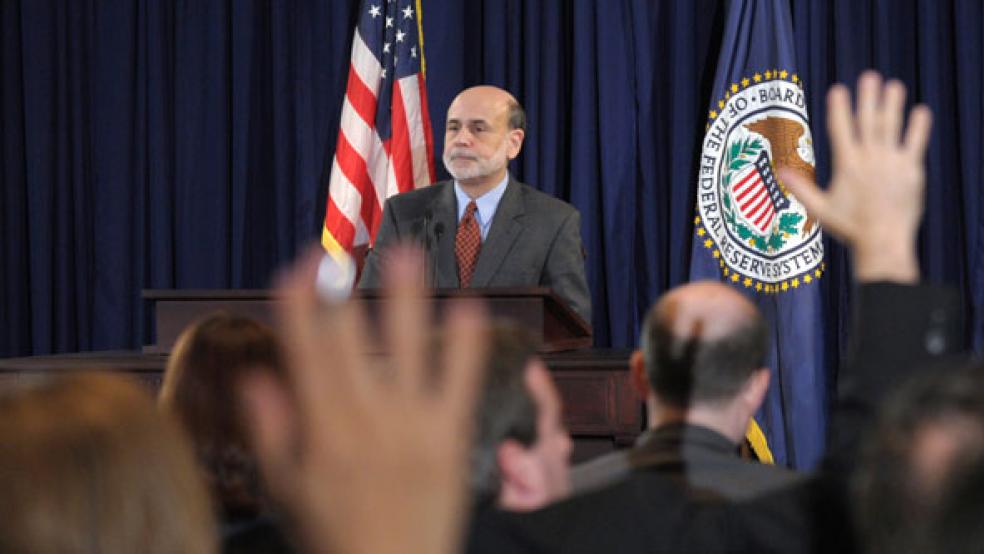Federal Reserve Board chairman Ben Bernanke in the first-ever press conference for a U.S. central bank chief signaled the Fed is beginning to focus more on inflation than on job creation despite the sluggish pace of the economic recovery.
“We’re looking very carefully at inflation,” he said Wednesday afternoon. “Headline inflation is at least temporarily higher. Our expectation is that inflation will come down to a more normal level. But we’ll be watching that carefully, as well as inflation expectations.”
The shift toward managing inflation expectations represents a significant but well-anticipated shift in Fed policy. The policy statement released at the conclusion of the regular meeting of the Fed’s monetary policy committee signaled monetary authorities will rein in the government bond purchasing program known as quantitative easing at the end of June as planned.
Last November the Fed announced that it would buy $600 billion in Treasury bonds to stimulate spending and loan-borrowing and push up stock prices. Fed officials have said the bond-buying helped strengthen the recovery and averted the risk of deflation, or falling prices.
But many conservative economists blame the program for build inflationary pressures in the economy, including the recent run-ups in oil, food and other commodity prices. More liberal economists complain that quantitative easy was inadequate for dealing with an unemployment rate that remains stuck at nearly 9 percent. And it was to those critics that he aimed his defense of the program.
“The conclusion that it was ineffective could only be validated if you thought the easing was a panacea and would return us to full employment over night,” Bernanke said. “At a time [last August, when the second round of bond purchases was announced], we were all worried about a double dip and deflation. We were very clear that it was not going to be a panacea but turn the economy in the right direction.”
And that it has done, he claimed, even as he all but ruled out doing more. “The tradeoffs have grown unattractive at this point. It’s not clear we can get substantial improvement in payrolls without additional inflation risk,” he said.
Still, the Fed won’t be shrinking its portfolio of government securities. Bernanke said that “we will continue to reinvest maturing securities, so the amount of securities we hold should remain constant. . . Put another way, the amount of monetary easing should remain constant going forward from June,” he said.
The nation’s top central banker confirmed what private sector economists have been projecting for weeks: economic growth in the first quarter, which will be officially announced tomorrow, was slower than expected. Bernanke said the report, due out Thursday, would show the economy growing at an annual rate a little under 2 percent, which is insufficient to reduce unemployment.
Yet “most of the factors that account for lower growth appear to be transitory,” he said, mentioning lower defense spending, lower exports and weather-related factors. Bernanke said “We’re in a moderate recovery,” which he described as “sustainable.”
Bernanke reiterated his view that tackling the nation’s long-term deficit problem should be a top priority for Congress and the Administration, but when asked if the budget cuts being contemplated on Capitol Hill might short-circuit that recovery, Bernanke replied only that “the cuts made so far don’t seem to have short-term consequences for economic activity.” Refusing to weigh in on the issue of greater short-term cuts, Bernanke added that “my preference for addressing the long-term deficit is to take a long-term perspective.”
The press conference marked the culmination of a long-term trend at the Federal Reserve toward greater openness. As recently as 1994, the Fed didn’t even announce its interest rate targets at the conclusion of its near monthly monetary policy meetings. The Fed yesterday said it was maintaining its target interest rate for overnight lending between banks at 0 to ¼ percent.
While holding a first central bank press conference generated tremendous media attention here, similar opportunities for the press are standard operating procedure in Europe and Japan. The Fed also publishes minutes of its meetings, and releases its medium- and long-term economic projections. “We’ve becoming a very transparent central bank,” Bernanke said, and a committee headed by board governor Janet Yellen is looking for additional steps to increase openness.
The latest Fed projections for the economy will be heartening to the Obama administration’s economic brain trust, who are hoping for a stronger recovery heading into the election season. While the Fed ratcheted it growth prospects for 2011 back to 3.1 to 3.3 percent from the previous 3.4 to 3.9 percent, it kept its 2012 projections at 3.5 to 4.2 percent, basically the same as its previous 3.5 to 4.4 percent growth projection.
The unemployment rate next year should fall to 7.6 to 7.9 percent, the Fed economists said, down from 8.4 to 8.7 percent this year. Unemployment won’t fall below 7 percent until 2013, the central bank said.
Inflation, on the other hand, is moving in the other direction. The Fed upped its projections to 2.1 to 2.8 percent for this year, up from the 1.3 to 1.7 percent projection it made in January. The Fed’s long-term goal is to keep inflation around 2 percent.
“One of the key things we’ll be looking is inflation expectations,” Bernanke said. “If firms aren’t passing along higher costs (from higher oil and commodity prices), then we’ll feel more comfortable watching and waiting and seeing how things evolve.
“If we see inflation expectations are becoming less anchored, we’ll have to respond to that,” he warned.
Related Links:
Bernanke Defends Fed’s Role in Running Economy (New York Times)
Bernanke: He’s Not Mr. Charisma (MarketWatch)





